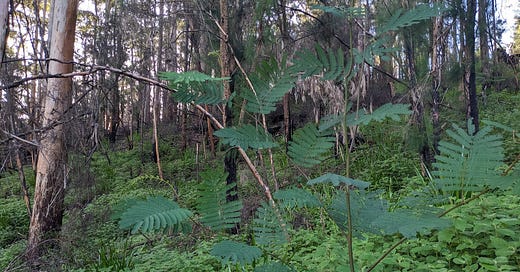No place here
I’ve been watching them grow, the spindly saplings of black wattle pushing up above the rejuvenating understorey on the hillside at the back of our block. It’s where The Fire burnt through. The bush is regenerating well, the understorey a sea of flourishing green. Most of the green is a profusion of native plants – karri hazel, net-leafed acacia, karri oak, sedges, karri wattle, and more. The weedy blackberries, thistles, and nightshades that dominated the flatter ground at the bottom of the hill don’t seem to have a hold in this patch of the forested hillside. But the black wattle is staking a claim.
I’ve been watching the wattles grow as I stand at the kitchen bench, my hands busy and my head thinking, ‘we have to do something about those wattles.’ But it feels like such a momentous task.
Black wattle is a weedy plant around here. According to my weed guide there are two species – Early Black Wattle (Acacia decurrens) and Mearns Black Wattle (Acacia mearnsii). To be completely honest, I’m not sure which of the two species is invading our hillside. Someone told me it was A. decurrens and I assumed that to be correct. But studying the descriptions in my weed guide, I think it might be A. mearnsii. The bark of the black wattles around here is more grey than brown and it was still flowering in summer. These seem to be points of difference between the two species. It’s a bit lazy of me to not put in the effort and identify it properly. Nevertheless, whichever it is – and I’m certain it is one or the other and not something else – it is a weedy plant around here. It’s definitely not the endemic karri wattle, which has smaller, finer leaflets. Both of the species of black wattle are from eastern Australia and were planted as a garden ornamental but liked conditions so much they spread.
I can see why these trees would be planted in gardens. They are tall and elegant, up to 10 metres tall, with smooth black or brown bark. In spring and summer, they drip with yellow flowers, little pom-poms of colour against the green. Of course, after the flowers come the seed pods and from there the plant spreads.
There’s a part of me that thinks, so what? It’s not as if this is an area of pristine bushland. It’s not as if the black wattle is a dangerous plant. It’s not poisonous (goats love it!). It’s not unattractive (quite the reverse). Like other wattles, it adds nitrogen to the soil.
But it is invasive. It is an environmental weed. Its presence changes the structure and composition of the bush. It simply doesn’t belong in bushland and because it seeds and spreads so readily, it doesn’t belong around here at all. That may well be a “speciesist” attitude, but it has to go. Those spindly seedlings rapidly covering the hillside have to go. They have to go now, before they grow into big trees and the unappealing job of today becomes a momentous task in the future.
The ground is soft after rain. It can’t be put off any longer. Rob and I don gloves and set to work. A lot of the young wattles are already taller than us. The stems are still thin, only a centimetre or two in diameter. They pull up remarkably easily. We rip them from the ground and leave them lying where they fall. Every time I look up from pulling one, there is another a metre or two away. I push through the wet undergrowth, tripping on sticks and logs, scrambling on the steep slope, bracing to hold myself upright. I try to watch where I am putting my feet, but I can’t always see the ground through the undergrowth. I step in holes. I stumble. The actual pulling of the wattles is surprisingly easy; it’s the getting from one plant to the next that is the hard bit. Just when we think we are done, we see another patch of maybe a dozen or so plants in and around a fallen log. More scrambling. More pulling.
Finally, it feels like the job is done. Even at that point, I know it won’t be a permanent fix. There will be ample more seed to push through another flourish of black wattle growth and there are a few tall mature trees just up the road that will provide yet more seed. In time, the understorey on our hillside may have enough integrity to not give space to the weeds, but until it has recovered from The Fire, it will be vulnerable to invasion. I walk back down the hill satisfied that we have it under control for now.
Later, standing in the kitchen, I can see a dark green patch on the hill across to one side from where we concentrated our efforts. We missed a bit. Oh well, another day, but soon, before they get too big to pull easily.
Thanks for reading,
Jill



